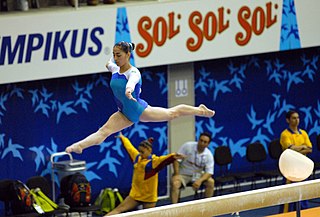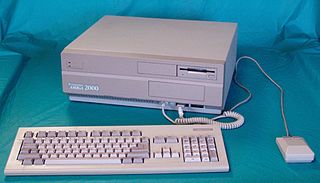
Gymnastics is a sport that includes exercises requiring balance, strength, flexibility, agility, coordination and endurance. The movements involved in gymnastics contribute to the development of the arms, legs, shoulders, back, chest and abdominal muscle groups. Alertness, precision, daring, self-confidence and self-discipline are mental traits that can also be developed through gymnastics. Gymnastics evolved from exercises used by the ancient Greeks that included skills for mounting and dismounting a horse, and from circus performance skills

The vault is an artistic gymnastics apparatus on which gymnasts perform, as well as the skill performed using that apparatus. Vaulting is also the action of performing a vault. Both male and female gymnasts perform the vault. The English abbreviation for the event in gymnastics scoring is VT

In computing, the expansion card, expansion board, adapter card or accessory card is a printed circuit board that can be inserted into an electrical connector, or expansion slot, on a computer motherboard, backplane or riser card to add functionality to a computer system via the expansion bus.

The Amiga 2000, or A2000, is a personal computer released by Commodore in March 1987. It was introduced as a "big box" expandable variant of the Amiga 1000 but quickly redesigned to share most of its electronic components with the contemporary Amiga 500 for cost reduction. Expansion capabilities include two 3.5" drive bays and one 5.25" bay that can be used by a 5.25" floppy drive, a hard drive, or CD-ROM once they became available.

Palm is an American tech company that developed and designed Personal Digital Assistants (PDAs), mobile phones, and software. Palm devices are often remembered as "the first wildly popular handheld computers," responsible for ushering in the smartphone era. Palm's first PDAs ran the Palm OS, were smaller than competing handhelds, and proved to the industry that there was a market for a new category of portable computing device.

The Commodore Amiga 4000, or A4000, is the successor of the A2000 and A3000 computers. There are two models, the A4000/040 released in October 1992 with a Motorola 68040 CPU, and the A4000/030 released in April 1993 with a Motorola 68EC030.

Pegasos is a MicroATX motherboard powered by a PowerPC 750CXe or PowerPC 7447 microprocessor, featuring three PCI slots, one AGP slot, two Ethernet ports, USB, DDR, AC'97 sound, and FireWire. Like the PowerPC Macintosh counterparts, it boots via Open Firmware.

The SpringBoard Expansion Slot was a versatile expansion slot devised for Handspring's range of Palm OS PDAs.

The Nokia 6670 is a smartphone from Nokia announced on September 24, 2004. Based on the Series 60 platform on Symbian OS, the phone is a tri-band business version of the consumer Nokia 7610, and features a 1.0 megapixel digital camera, 8MB of storage and a 65,536 colour 176x208 TFT screen. Software includes viewers for Microsoft Word, Excel, PowerPoint and PDF files, a full HTML compatible web browser, and a GPS-like application that generates positioning information from the GSM cell data. The Series 60 platform allows for many programs to be added, and also with the inclusion of Java Apps and Games. Its 123 MHz ARM-9 processor can handle many applications at a time, and it can calculate 16000 fibonacci numbers in 35 seconds, as calculated using FPC Bench.
Advanced Telecommunications Computing Architecture is the largest specification effort in the history of the PCI Industrial Computer Manufacturers Group (PICMG), with more than 100 companies participating. Known as AdvancedTCA, the official specification designation PICMG 3.x was ratified by the PICMG organization in December 2002. AdvancedTCA is targeted primarily to requirements for "carrier grade" communications equipment, but has recently expanded its reach into more ruggedized applications geared toward the military/aerospace industries as well. This series of specifications incorporates the latest trends in high speed interconnect technologies, next-generation processors, and improved Reliability, Availability and Serviceability (RAS).
The Palm m500 series of handheld personal digital assistants consisted of three devices: the Palm m500, Palm m505, and Palm m515. The series was a follow-up to the popular Palm V series with a similar, though slightly shorter, footprint and form factor.

The Commodore A1060 Sidecar is an expansion hardware device developed by Commodore and released in 1986 for the Amiga 1000 computer. It features a complete PC XT-clone system mounted in an expansion case which connected to the expansion bus on the right side of the Amiga 1000 computer, sitting beside it similar to a motorcycle's sidecar, hence the name.

A springboard is a platform set upon one or usually multiple springs used in artistic gymnastics to propel a gymnast who jumps upon it further than if they had otherwise jumped off a fixed platform. The springboard is a vital part of the vault event, and is commonly used in some routines of other events, such as the balance beam, or uneven bars, to start the event by springing onto the apparatus. The springboard is usually about 2 feet (0.6 m) wide and 4 feet (1.2 m) long. The number of springs in a springboard depends on the gymnast.
Mark Ruiz, is an Olympic diver from Puerto Rico. Ruiz represented the United States in the 2000 Olympic Games and the 2004 Olympic Games.
Handspring, Inc was a maker of Palm OS–based Visor- and Treo-branded personal digital assistants. In 2003, the company merged with Palm, Inc.'s hardware division.

The BeagleBoard is a low-power open-source single-board computer produced by Texas Instruments in association with Digi-Key and Newark element14. The BeagleBoard was also designed with open source software development in mind, and as a way of demonstrating the Texas Instrument's OMAP3530 system-on-a-chip. The board was developed by a small team of engineers as an educational board that could be used in colleges around the world to teach open source hardware and software capabilities. It is also sold to the public under the Creative Commons share-alike license. The board was designed using Cadence OrCAD for schematics and Cadence Allegro for PCB manufacturing; no simulation software was used.

Sam440, also known by Sam or its codename Samantha, is a line of modular motherboards produced by the Italian company ACube Systems Srl. The Sam440ep version is a Power Architecture motherboard based on the PowerPC 440EP system-on-a-chip processor which includes a double-precision FPU. It is made by AMCC. Their primary targets are the industrial and embedded markets, running operating systems such as Linux and AmigaOS 4.

The PandaBoard is a low-power single-board computer development platform based on the Texas Instruments OMAP4430 system on a chip (SoC). The board has been available to the public at the subsidized price of US$174 since 27 October 2010. It is a community supported development platform.

















